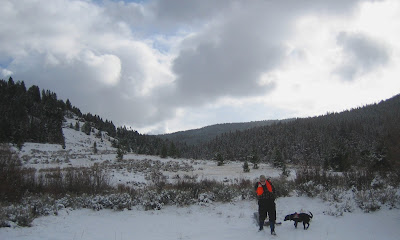[Notice to sensitive readers: this blog post includes photos of dead animals. -ER]
Frank Ackerman, my colleague in Computer Science, decided to take up deer hunting this year--at the age of 70+. Montana Tech, the little college in Butte, Montana, where I work, is a tightly knit community where faculty are generally helpful and supportive of one another. Frank and his wife, Hwe-Chu Tu, have enjoyed meals of elk, deer, and antelope at our home. Hwe is an excellent cook and became interested in preparing wild game. When Hwe began questioning me about what it would take for Frank to become a hunter, his fate was sealed.
We hunted once for mule deer, walking the steep rocky ridges along the Big Hole River, but did not see a legal buck within shooting range. We hunted once for whitetails at a favorite ranch in the beautiful Ruby Valley and while my hunt was successful Frank's was not. This changed last night as we sat patiently watching many deer for an hour or more--all out of range or at an unsafe angle given nearby houses. We sat patiently watching, the sun dipped below a high mountain ridge, the temperature dropped as cool air slid down the mountain slopes into the valley, and then -- magically -- deer emerged from the safety of dense willows along the river to feed in the hayfields around us .
Frank chose a nice doe, aimed carefully, and fired. The deer dropped and the rest of the herd, startled only momentarily, returned to feeding. "Now what do I do?" (You have another tag?) "Yes." (Shoot.) He did and another deer fell (a spike buck with antlers less than 4"--technically an "anterless deer"). "Now what?" (You have another tag?) "Yes." A third doe died. As light faded from the sky, we gathered our gear, field-dressed the deer, dragged them to the nearby road, and I made a short hike to bring the truck around:
This morning, we hung the deer in their garage prior to butchering. Here are Frank and Hwe with their year's supply of meat (note the deer carcasses are split and propped up to facilitate cooling):
The Ruby Valley is seriously overpopulated with white-tailed deer. Some property owners do not allow hunting, major predators are scarce, and hayfields are planted with tasty alfalfa--a sure recipe for deer propagation. The huge deer population is a problem for cattle ranchers, gardeners and landscapers, and drivers. At the ranch where we hunt, one signs an agreement to shoot at least 3 if possible. It is not really hunting (the best strategy is to sit quietly and watch) but it does require patience, careful watching, and accurate shooting. For a novice hunter, it is a good learning experience and I have started several hunters in this way: my own daughter Emily; "Little Brother" A.J., Howard Smith, and now Frank.
Experienced and novice hunters alike should practice shooting so that are confident of the rifle and the range at which they can consistently hit a small target. Many hunters are terrible shots. There are various reasons: many are too cheap to buy ammo for practice; others are "too busy" to practice; some have never learned basic marksmanship skills. Too many times, I've had even experienced hunters "borrow" my rifle after they missed. This sort of carelessness results in many wounded animals--a terrible fate that any hunter worth their salt should be ashamed of.
Tracking, AI, Human Gaits
3 weeks ago






































